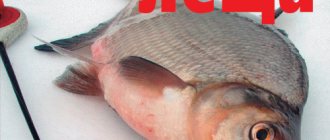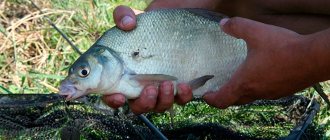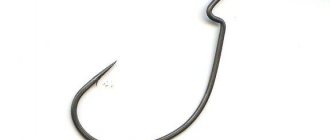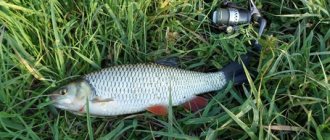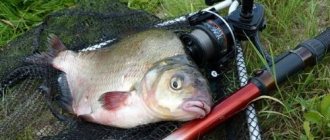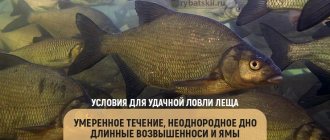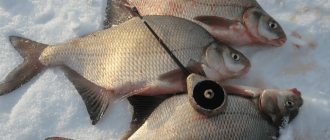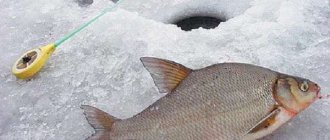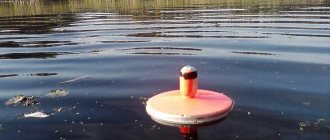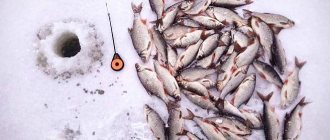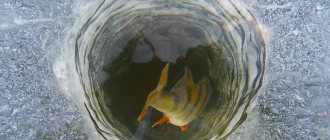Design features for winter
The combine is a multi-hook tackle, which is held at the bottom by a feeder with a load. It is a fairly catchy structure, since the hooks, which are tied to the main line lower than the load, are carried away by the current at the time of descent and therefore the bait ends up in the feeding area.
The advantage of this tackle for catching bream in winter is its roughness and strength. This is due to fishing conditions, which include the presence of a fast current and a fairly large weight of the catch.
Bream is a cautious fish and reacts quite warily to any kind of gear. Therefore, in order to catch it, it became necessary to search for a whole range of techniques and tactics.
The harvester rig is essentially a regular fishing rod for winter fishing, which includes a feeder, hooks and a nod. In this design, the heaviest element is the feeder, which lowers evenly into the water. This is done so that after the combine is immersed in water, the current carries the equipment away from the hole, and the food is washed out of the feeder by the current to where the hooks will be located.
With this design and operating principle of the combine, the bream cannot have any fears, its alertness disappears and it gets hooked.
The equipment of the combine was created by fishermen exclusively for catching fish in the current , since these places are enriched with oxygen and schools of fish are stationed in these places. Also, the combine has a second name - a descender. It does not have such disadvantages as the movement of the fishing line and the removal of the hook.
How to fish with a combine in winter on the river
Depending on the time of winter: first ice, deep winter and last ice, you need to vary the equipment and fishing tactics.
Search for fish
To find fish in winter, for example bream, you need to concentrate on the following locations:
- elongated and curved depressions located under steep banks, at a bend in the river;
- wide river channels;
- extended and local pits on the river, the bottom of which is covered primarily with a layer of clay and silt.
In backwaters and backwaters, where there is no current or it is very weak, it is difficult to find bream; it prefers to stay in locations with the current. But carp, crucian carp and perch are quite possible.
Bream sites
Tactics and fishing techniques
Holes are drilled using an ice drill. Hole diameter – 110-150 mm. To avoid chafing of the fishing line, the edges of the hole must be well processed. The best place for fishing will be an area in which the current has different directions and intensities, and there are also differences in depth.
When fishing with a slide, the most popular bait/groundbait is bloodworm. The bloodworm is located strictly at a given point, does not go with the flow and attracts peaceful fish well.
Bloodworm
Small freshwater amphipods are also excellent bait and groundbait. They slip very well through the holes made in the feeder, and the current carries them towards the hooks.
For feeding in feeders, you can prepare porridge:
- 1 part bran;
- 1 part mashed cookies;
- 2 parts breadcrumbs used for breading;
- 1 part crushed seeds.
Depending on which hook the majority of bites will occur on - the first or the last, it is recommended to move or, conversely, move away the feeder so that the maximum number of hooks gets into the promising fish holding area.
Fishing on the current: features
It is the current that allows the combine harvester gear to take the correct position. Drilling the hole at an angle, that is, when the lower part should be directed towards the current, will reduce friction and the destructive effect of ice on the fishing line. Bream stays mainly near the edges, in holes, but goes out into the current in search of food.
The hooks and bait are first lowered into the hole, then the feeder.
The fishing rod must be installed so that the nod can capture even the most cautious fish timidly trying to eat the bait/bait.
You need to cut smoothly but quickly. Fishing is carried out with a stretched line. Bream has good hearing; even the creaking of snow can scare it away. Therefore, you should not walk on the ice again.
Fishing with a combine in winter on the river has three main components for success:
- choosing a fishing spot;
- choice of bait;
- precise selection of tackle length.
The fisherman must move the feeder, changing the length of the working part. This manipulation is carried out in order to detect the correct distance at which most bites occur.
It is necessary to vary the length of the lead to place the hooks in the promising zone
A practical way to catch bream and other fish on the river using a combine harvester
Let's consider an accessible and effective fishing technique:
- In order to cover the largest possible area, it is necessary to carry out stepwise drilling of holes in a checkerboard pattern from one bank to the other.
- After the holes are drilled and they are cleared of ice, the first working hole can be pre-fed. To do this, using a dump truck-type feeder, bait is delivered in a form that is slowly and for a long time eroded by the current.
Feeder dump truck in the form of a pyramid - Then the equipment is lowered into the hole. When the outlet with leashes picks up the current, you need to quickly lower the feeder to the bottom in free fall.
- A fishing rod is installed vertically near the hole.
After the bite, the tackle is checked, the knocked down bait is put back on the hooks, and the bait is poured into the feeder. And the process repeats all over again.
Fishing on the Ob River on the slopes - catching bream, feeding the combine and tactics:
Catching carp in summer using combine-type gear
The combine fishing tackle is good for carp fishing. You can also do it yourself. Installation is very simple. 4 leashes are tied to a small spring made of thin wire and all together attached to the main fishing line. For leashes, nylon thread or braided fishing line 10 cm long is used. Hooks No. 6-10 with a short shank are tied to the made leashes.
Attention! It is important to choose a stainless steel wire for the spring, otherwise the carp will not get close to the bait and there will be no catch!
This type of tackle is attached to a spinning rod. Dough is used as a nozzle.
Carp descent
Fishing technique
The main advantage of fishing with a descender is that there is no need to create a large number of holes. This is especially true at the end of the winter fishing season, because... Drilling holes is difficult due to the thickness of the ice crust.
However, for productive fishing, it is recommended to make the holes in steps. This facilitates catching fish over a large area, searching for large concentrations of bream, and with this method of drilling, the drains do not get confused with each other.
The depth of fishing with a combine in the current is about 5 meters . It is recommended to adhere to this condition, because in most cases bream lives closer to the bottom of the reservoir. When fishing in shallow water, the depth indicator may deviate downwards. Also, there is a recommendation that drilling holes should be carried out in places where the channel turns or narrows, or above holes.
The main bait is bloodworms; pea mastyr can be used closer to the end of the winter season.
To set up the feeder, you need to track a couple of bites. This is how the side of the bite is determined. If the first hook collects more catch, then this indicates that there is not enough bait for the second and third hook. If the bite occurs mostly on the last hook, there is a need to move the bait away from the first and second hook.
The factor influencing the success of bream fishing is the restraint and accuracy of the fisherman . The bream's excellent hearing means that at the slightest noise it can easily swim away.
Proper refueling of gear and immersing it in water is one of the main conditions for fruitful fishing.
- The bait is placed in the feeder, the bait is placed on the hooks.
- The hooks are the first to sink into the hole. Depending on the strength of the current, the dive time may increase or decrease, because... hooks should not get tangled.
- The feeder is immersed in water to the very bottom.
- The fishing rod is placed on the stand, and the remaining fishing line is wound onto the reel.
After washing out the bait from the feeder, the bream, smelling it, somehow swims past the hooks. Further, it all depends on the chosen bait.
What is a combine harvester: structure and features
A combine is a simple winter fishing rod that has a nod, a feeder and several hooks. The peculiarity of the operation of the launcher is that after a hole is made in an area with a current, it is necessary to lower the harvester under the ice. At this time, the hooks are picked up by the current and washed away.
The feeder is heavier than the hooks, so it descends evenly in a vertical direction directly to the bottom under the hole. During descent, the bait is washed out of the feeder by the current and moves towards the hooks, creating a bait spot in their area, attracting peaceful fish.
What elements does a combine harvester consist of: photo
In order for the combine rig to be effective at great depths and in currents, it must be well tuned. Winter descent for ice fishing for peaceful fish includes:
- fishing rod;
- main line;
- a hard nod;
- sliding sinker;
- a group of hooks;
- feeder
Combine harvester schematically
To make the handle of a winter fishing rod, lightweight materials can be used: fine-pored rubber or foam. The whip for underwater fishing should be hard and 25 cm long. The optimal diameter of the reel with a locking element is 45 mm.
Guards made of spring and lavsan have good rigidity and are an ideal bite alarm. The length of the nod is 15-20 cm.
Winter fishing is effective with main monofilament green or yellow fishing line with a diameter of up to 0.25 mm. The tail part of the combine should be formed by double loops with a distance of 0.7 to 1.2 meters. 3 leashes 10-20 cm long are tied to them. To install the leashes, a fishing line with a diameter of 0.12-0.2 mm is used, depending on the fish and the conditions of the fish.
High-quality hooks with a long shank No. 6, 7, 8 are attached to the leashes, with a loop-to-loop knot.
Winter fishing with a combine is especially effective if the fish are active; in such conditions, one cast into a hole can bring a good catch of up to 3 peaceful fish. The fishing line with hooks does not get tangled and does not cling to anything.
Installation diagram of a combine for winter fishing
You can make a feeder yourself:
- A plastic container with a lid is required.
- You should screw the sinker with two self-tapping screws, and screw another self-tapping screw between them, mounting a small loop of wire above it.
- Using a hot nail, make 7-9 holes on both sides of the plastic container. The bait mixture will be washed out through them.
- Pull a piece of monofilament through the hole.
- Tie a vein to the loop on the weight and screw on the cap.
- The clasp loop is formed at the top of the line.
Homemade feeder for a combine harvester
In addition to homemade feeders, rectangular feeders are suitable for the combine, but they are not so effective.
How to make and assemble winter harvester equipment with your own hands
The stages of gear manufacturing have the following sequence:
- First you need to install a reel on the fishing rod, do not forget about the bite alarm. Measure a line 30 meters long and pass it through the gatehouse. Then tie it to the reel with a reverse figure eight or similar knot.
- The main main line must pass through the swivel with a carabiner; 3 stops must be made.
- Using a knot, tie the leash to the main line. The length of the leash is 1-1.5 meters.
- Find the edge of the conductor and tie a heavy lead jig. Next, retreating a distance of 40 cm, you need to tie another leash. Next you need to tie 2 hooks in the same way.
- Tie the loose ponytail in a loop. Place the feeder on the swivel with a carabiner.
Heavy jigs are used for fishing in the current, as they sink to the very bottom where the fish are.
How to assemble a combine harvester for winter fishing with a feeder - installation diagram, collection and modification of equipment:
The combine fishing tackle is ideal for winter fishing for peaceful fish of the carp family: bream, roach, crucian carp, silver bream, as well as perch, which belongs to the perch family.
How to choose winter fishing equipment?
To make winter fishing effective and comfortable, you need to choose the right combine gear. They include:
- Nod and rod. You must select these elements based on your own convenience. There are two basic rules that are important to follow:
- the rod is installed in such a way as to make instant hooking conveniently;
- the nod must be equipped with a sound device for notification.
- A reel that should hold 30-35 meters of fishing line.
- Fishing line . You should choose a medium thickness, about 0.35.
- Leashes , maximum length 20 cm.
- Hooks . High-quality sharpening is a mandatory feature. It is also recommended to wrap it with white thread and treat it with a luminous substance for the most attractive look.
- Feeders , which are selected based on the type of bait. Its weight should correspond to the strength of the current and allow it to remain in one place.
Descendant for summer
Fishing on the descent in the summer is carried out from a boat, and involves the use of an onboard fishing rod - a bream. This type of fishing rod is designed specifically for catching bream.
Typically, a fishing rod is represented by a long base, equipped with a reel and, most often, an audible alarm. Some fishermen prefer silent alarms, presented in the form of a strong nod at the end of the tackle.
The design of the bream gives priority to sound notification, and the fishing rod itself has an individual wire design at its base.
Due to the fact that fishing from a boat requires certain tactics, it is necessary to use special bottom gear. At the same time, they are quite multifunctional. A fairly strong fishing line and a heavy sinker are the main requirements for holding the gear in the current.
It is also possible to improve the gear by attaching a feeder using a carabiner. This allows you to increase the functionality of the onboard fishing rod with the use of complementary foods.
Spring fishing gear
The simplest option involves having a regular reel with fishing line, to which a spring with leads is attached. This is a kind of primitive bottom tackle that allows you to catch carp at some distance from the shore.
A more advanced option involves having a fishing rod equipped with a spinning reel with reliable fishing line, in the form of braid or monofilament. It is possible to equip a fishing rod using inexpensive telescopic rods, but at the same time, you should remember that carp is a serious fish and if a good specimen bites, you can be left without a fishing rod.
Catching tackle for carp fishing can be obtained by purchasing and equipping a powerful feeder rod. It’s even better if you use a special fishing rod for carp fishing. They are equipped with powerful (size 3000-6000) spinning reels and reliable braided fishing line. By using such rods and making the appropriate equipment, you can count on the effectiveness of your entire fishing trip. As a rule, feeder rods are equipped with different tips, which allows you to choose exactly the one that is suitable for carp fishing. Moreover, the tip can serve as a bite alarm, although more advanced electronic alarms can be used.
How to tie correctly?
Properly connected gear is a guarantee of successful fishing in relatively average currents and at great depths. The process of assembling a bream harvester includes the following steps :
- winding fishing line onto a fishing rod reel;
- threading the end of the fishing line through the spring structure of the leash;
- hanging a load or feeder on a monofilament;
- putting a stop cambric on the fishing line;
- attaching a swivel to the end of the monofilament;
- tying with a loop to attach leashes on a piece of fishing line 4 meters long;
- attaching a piece of fishing line to the free end of the swivel;
- attaching leashes to loops;
- A large lead jig is installed at the end of the rig.
The described type of gear assembly ensures a catch of large bream.
How to do it yourself?
How to make a winter or summer descender? To make it yourself, you must follow a certain sequence of actions.
- Prepare hooks in advance that need to be rewound with white thread and apply luminous varnish to the surface.
- As a fishing rod, you can use a nodding fishing rod that can support the weight of the fish. The ideal material for making such a fishing rod is lavsan. The most convenient would be a fishing rod with a stand.
- Installation of gear, which includes the following steps: Installing a reel with fishing line up to 30 m and threading it into the nod. You can use a metal spring as a nod.
- Before installing the rubber stoppers, the main fishing line is inserted through the swivel with a carabiner.
- Tying the leader material with a knot to the fishing line.
- Installing a lead jig at the end of the main leash.
- Tying an additional leash with a luminous hook at a distance of 40 cm from the jig.
- Attaching a leash, 30-40 cm long, to a weighed feeder.
- Tying a loop at the free end of the leash.
- Installing the feeder on the swivel carabiner.
Making a feeder using a transparent jar with a lead weight. To run the fishing line into it, you need to make holes in the bottom. At the end, thread a leash 30-40 cm long through the bottom of the jar and tie a loop.
For fans of lively fishing, winter bream fishing with a combine harvester may turn out to be uninteresting and monotonous. However, today there are quite a lot of fans of this type of fishing, since it is simple and accessible to everyone. This is why even inexperienced fishermen can successfully catch bream using a combine harvester .
Fishing places
Harvester tackle for bream is used when fishing in places such as:
- Wide reach pits (channel ditches) with depths of at least 4-5 m;
- Curved and elongated depressions under steep banks at a bend (turn) of the river;
- Local and extended holes in other parts of the river with clayey bottom soil covered with a small layer of silt.
Fishing for bream using a combine harvester will not be effective in places where the current is very weak or does not exist at all (small backwaters and backwaters).
